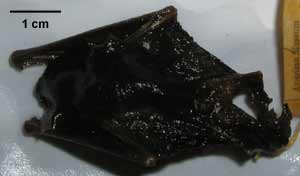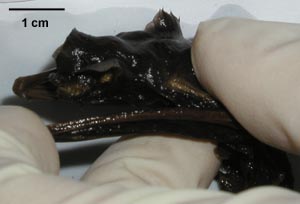Furipterus horrens, the thumbless bat, is misnamed – it clearly has a thumb, although the digit is reduced and is largely enclosed in the edge of the wing membrane. These tiny bats live in the Neotropics from Costa Rica south to Brazil. They fly like large moths through the forest understory, and roost in hollows in fallen trees and in small caves. Furipterus horrens is one of only two species in the Furipteridae. |
|

About the Species
This specimen was made available to The University of Texas High-Resolution X-ray CT Facility for scanning by Dr. Nancy Simmons of the American Museum of Natural History. Funding for scanning was provided by a National Science Foundation grant (DEB-9873663) to Dr. Simmons, and funding for scanning and image processing was provided by an NSF Digital Libraries Initiative grant to Dr. Timothy Rowe of The University of Texas at Austin.

Dorsal view of the scanned specimen.

Lateral view of the scanned specimen.

About this Specimen
This specimen was scanned by Matthew Colbert on 21 February 2003 along the coronal axis for a total of 1485 slices. The specimen was mounted in florists foam for scanning. Each slice is 0.039 mm thick, with an interslice spacing of 0.039 mm and a field of reconstruction of 32.0 mm. The original slices were reduced from a resolution of 1024x1024 pixels to 768x768 pixels for image processing.

About the
Scan
Literature
& Links
None available.

Additional
Imagery
|

